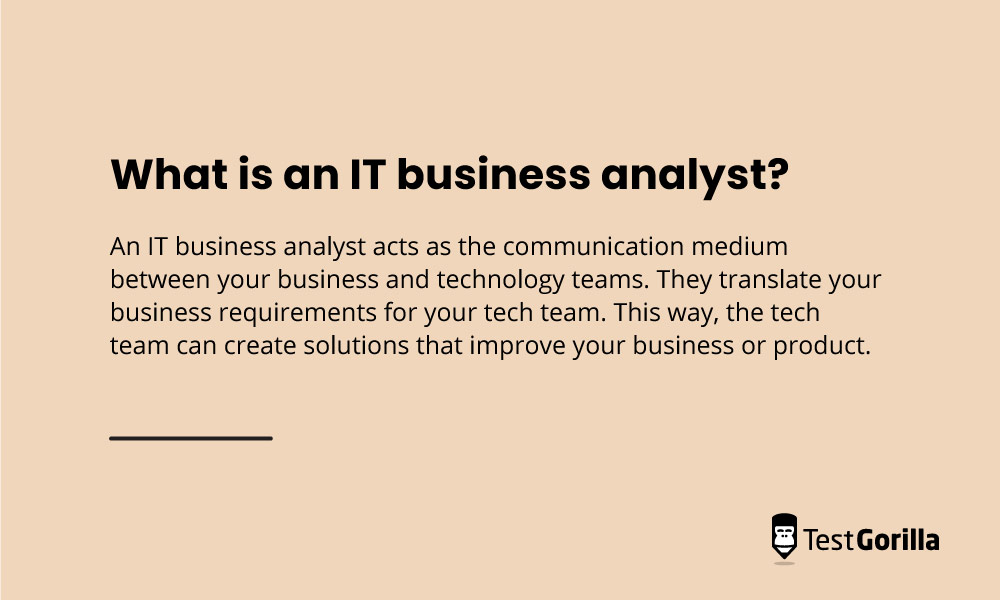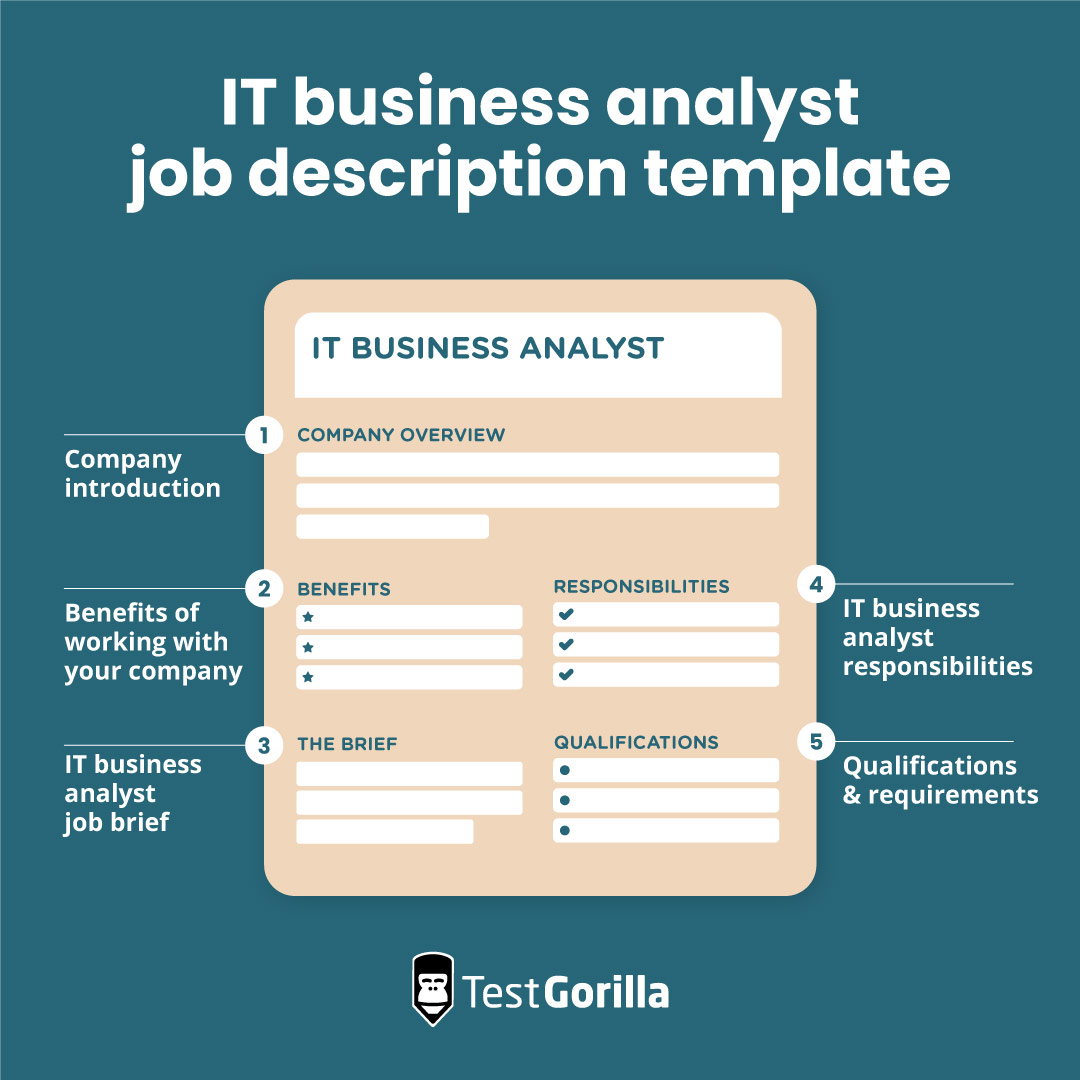Writing a job description for an IT business analyst is tough because their role is complex and ever-changing, varying from company to company. Capturing everything you need in your candidates in a short amount of space can be difficult.
To create an effective job description, you should provide a comprehensive overview of your company, the job’s requirements, and the essential competencies of the IT business analyst you’re looking for. A job description lacking these critical elements can lead to a mis-hire who significantly derails your business’s progress.
Our guide makes writing an IT business analyst job description easy by outlining the skills candidates need, providing a job description template, and sharing common pitfalls. With this information, you’ll be on track to find the best IT business analysts.
Table of contents
- What is an IT business analyst?
- 7 key skills for IT business analysts
- How to write an effective IT business analyst job description
- IT business analyst job description template
- 3 things to avoid when writing a job description for IT business analysts
- Next steps: Attracting and assessing IT business analyst candidates
- FAQs
What is an IT business analyst?
An IT business analyst acts as the communication medium between your business and technology teams. They translate your business requirements for your tech team. This way, the tech team can create solutions that improve your business or product.
IT business analysts observe your business processes, analyze them, and determine and document which tech or business solutions your organization needs to meet its objectives.
7 key skills for IT business analysts
Ensure your IT business analyst has these seven general skills:
Problem-solving and analytical skills to identify issues and develop effective solutions
Proficiency in IT frameworks, databases, and programming languages such as Python or R
Familiarity with data modeling and business intelligence tools
Strong written and verbal communication skills to convey technical information clearly to non-technical stakeholders
Experience in planning, executing, and closing projects
Understanding of business operations, strategies, and objectives
Industry-specific knowledge
The best insights on HR and recruitment, delivered to your inbox.
Biweekly updates. No spam. Unsubscribe any time.
How to write an effective IT business analyst job description
Writing an effective job description is the first step toward attracting the right candidates. The description should effectively depict the ideal candidate for the role and be easy to read and understand.
Here’s how to do it:
Understand the role
Before hiring an IT business analyst, think about your company's specific tech challenges and goals. This will help you accurately describe the exact tasks you need the analyst to handle.
Use a clear title
Your title should immediately tell your candidates what role the job ad is promoting. Use a title that describes the job, like “IT Business Analyst,” and avoid fancy titles that might confuse people, such as “Technology Optimization Strategist” or “Business Systems Innovator.”
Write a brief summary
Explain which aspects of your business you’d like to improve using technology. For example, a restaurant chain might want to improve its order timeframe and accuracy. This chain might need an analyst to determine which technology can achieve this goal. By being clear about what you need, you'll attract candidates who can help you achieve your goals.
List main responsibilities
Describe key day-to-day tasks like analyzing business needs, designing IT solutions, managing projects, and collaborating with stakeholders to set the right expectations for the role.
Mention necessary skills and qualifications
To deter unqualified candidates from applying, list the skills and qualifications needed, like familiarity with IT systems, as well as any work experience or education you require. Don’t neglect soft skills like problem-solving and communication, as IT business analysts need these skills to do their jobs well.
IT business analyst job description template
Use the job description template below to attract compatible IT business analyst candidates. Make changes where applicable to suit your company’s hiring goals.
Company introduction
Introduce your company here by describing what your business does, who your business serves, what the company’s goals are. Provide background information – such as when your company was founded – and any notable achievements or awards your company has earned. Then, discuss the importance of an IT business analyst to your business.
Benefits of working with [your company]
Here, provide a detailed rundown of the benefits your organization offers. Provide information about your company’s culture and the professional growth trajectory candidates can expect so they can determine their compatibility.
Emphasize the perks that make the role attractive – for example, paid time off, remote or flexible work options, a home office or travel stipend, or company-issued devices.
IT Business Analyst Job Brief
[Company name]
Job Title: [For example, Lead IT Business Analyst, IT Business Systems Analyst, or Technical Business Analyst]
Reports to: [For instance, Director of IT or Product Manager]
Position type: [For example, full-time, part-time, on-site, remote, or hybrid]
[Compensation details]
IT business analyst responsibilities
Analyze and document business processes
Design, test, and implement IT solutions
Collaborate with stakeholders to define business requirements
Manage IT projects to ensure they meet business objectives
Adapt to remain current with IT trends
IT business analyst qualifications and requirements
Bachelor’s degree in IT, business, or related field
[Number]+ years of experience as an IT business analyst
Strong analytical and problem-solving skills
Excellent communication and collaboration skills
Familiarity with IT frameworks and programming languages
3 things to avoid when writing a job description for IT business analysts
Be sure to avoid these three common pitfalls:
1. Vaguess or overwhelming detail
While it’s important to provide enough information, avoid being overly vague or excessively detailed. Provide essential details about responsibilities and expectations without overwhelming candidates.
For instance, "familiarity with documentation tools" is too vague, as candidates won’t know which documentation tools they should know. But saying that candidates should have proficiency in every available documentation tool will scare away otherwise-qualified job-seekers. To strike a balance, list the specific documentation features you’d like candidates to be familiar with, such as JIRA, Confluence, or Visio.
2. Discriminatory language
The job description must be inclusive and devoid of discriminatory language. For example, it’s discriminatory to say you want a young IT business analyst. This wording excludes older candidates.
Using inclusive language can help you comply with anti-discrimination laws, and by doing so, you can engage in fair hiring practices.
3. Unrealistic qualifications
Don’t list qualifications that aren’t essential for the job because this can deter potentially great candidates from applying. Be clear about the qualifications you require and the ones you prefer. For example, you might require candidates to have experience in project management, but emphasize that you’ll still consider them if they’re missing preferred qualifications – like familiarity with JIRA.
Next steps: Attracting and assessing IT business analyst candidates
A compelling IT business analyst job description will lead prospective candidates to your doorstep. However, you’ll need to assess an IT business analyst’s skills to ensure you’re selecting the right candidate.
TestGorilla’s comprehensive testing platform can help you streamline this process. For example, our IT Business Analyst test helps you measure candidates’ on-the-job skills.
You can combine this with other assessments, including our technical skills, personality, and cognitive ability tests. This multi-measure approach will help you gain a complete understanding of each candidate’s hard and soft skills, enabling you to find a candidate who can work with you long-term.
Additionally, structured interview questions for IT business analysts can help you assess your candidate’s suitability for the role.
Consider using our video interview feature to ask in-depth business analyst interview questions that highlight star candidates in your talent pool.
FAQs
Q: Which level of experience should I require in my job description?
For entry-level IT business analyst roles, ask for 1-2 years of experience or equivalent education or training. For senior or lead roles, require 5-10 years of experience.
Q: Should the job description focus more on technical skills or business skills?
An IT business analyst job description should focus equally on technical and business skills. While technical proficiency is essential, the analyst must also understand business operations and strategies to align technology solutions effectively with business objectives.
Attract and assess the right talent with TestGorilla
A skilled IT business analyst can effectively assess and determine the technological solutions you need to improve your organization’s efficiency and growth. A well-written job description will describe your company and accurately detail the role’s requirements to attract the right talent.
After using your job description to draw in applicants, you can use TestGorilla’s business analyst assessments to help you identify skilled candidates who can excel in the role. Pair role-specific tests with other assessments from our 300+ tests and increase your chances of making a successful hire.
Take our quick product tour or sign up for our free plan today!
You've scrolled this far
Why not try TestGorilla for free, and see what happens when you put skills first.


















